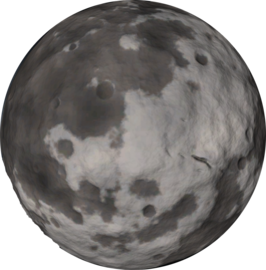Dres
| Dres | ||
| Dres as seen from orbit. | ||
| Dwarf planet of Kerbol | ||
| Orbital Characteristics | ||
| Semi-major axis | 40 839 348 203 m [Note 1] | |
| Apoapsis | 46 761 053 692 m [Note 1] | |
| Periapsis | 34 917 642 714 m [Note 1] | |
| Orbital eccentricity | 0.145 | |
| Orbital inclination | 5 ° | |
| Argument of periapsis | 90 ° | |
| Longitude of the ascending node | 280 ° | |
| Mean anomaly | 3.14 rad (at 0s UT) | |
| Sidereal orbital period | 47 893 063 s | |
| 2 217 d 1 h 37 m 43.1 s | ||
| Synodic orbital period | 11 392 903.3 s | |
| Orbital velocity | 4 630 - 6 200 m/s | |
| Physical Characteristics | ||
| Equatorial radius | 138 000 m | |
| Equatorial circumference | 867 080 m | |
| Surface area | 2.3931396×1011 m2 | |
| Mass | 3.2190937×1020 kg | |
| Standard gravitational parameter | 2.1484489×1010 m3/s2 | |
| Density | 29 242.045 kg/m3 | |
| Surface gravity | 1.13 m/s2 (0.115 g) | |
| Escape velocity | 558.00 m/s | |
| Sidereal rotation period | 34 800.000 s | |
| 1 d 3 h 40 m 0 s | ||
| Solar day | 34 825.305 s | |
| 1 d 3 h 40 m 25.3 s | ||
| Sidereal rotational velocity | 24.916 m/s | |
| Synchronous orbit | 732.24 km | |
| Sphere of influence | 32 832 840 m [Note 1] | |
| Atmospheric Characteristics | ||
| Atmosphere present | No | |
| Scientific multiplier | ||
| Surface | 8 | |
| Splashed | N/A | |
| Near space | 7 | |
| Outer space | 6 | |
| Recovery | 6 | |
|
| ||
Dres is the fifth planet[1] of the Kerbol star system. It is located between Duna and Jool in a somewhat eccentric and inclined orbit. It is considered to be the Ceres analog for the game. It is similar to Moho and Eeloo in that it has no atmosphere and no natural satellites. Dres has the least gravity of any planet in the Kerbol system. While it is classified as a dwarf planet by the developers, it currently meets the IAU's definition of a planet.
Contents
In-game Description
| “ | Dres is a very small planet. It was the first planet considered to be a dwarf. Its orbit is highly irregular and, together with its size, it took a long time to discover since half the time it was not where scientists expected to find a planet. Due to its nature of frequenting the bad parts of space. This dwarf planet was officially labeled as Not to be trusted by the scientific community. — Kerbal Astronomical Society |
” |
Geography
The surface of Dres appears light grey and is rocky and uneven, similar to that of Mün, with a surface covered in regolith rubble. Unlike Mün, Dres has large patches of what appears to be ice. The highest points are just under 5.7 km in altitude. One notable geographic feature is a canyon just south of the equator, which is several kilometers deep.
Cratering
The surface of Dres has several craters. However, unlike other planetary bodies, none are very prominent, the largest being slightly under 13 km in diameter.
In total, 42 craters have been positively identified. Another 5 are still waiting for confirmation. The spreading of the craters is biased to the western, particularly the northwestern, hemisphere of Dres.
| Quadrant | No. of craters (%) | No. of Craters |
|---|---|---|
| North-East | 19.0% | 8 |
| South-East | 7.5% | 4 |
| North-West | 42.9% | 18 |
| South-West | 28.6% | 12 |
| Total | 100% | 42 |
Biomes
Dres has 8 biomes.
Biome list
Reference Frames
| Time warp | Minimum Altitude |
|---|---|
| 1× | Any |
| 5× | 10 000 m |
| 10× | 10 000 m |
| 50× | 30 000 m |
| 100× | 50 000 m |
| 1 000× | 100 000 m |
| 10 000× | 200 000 m |
| 100 000× | 300 000 m |
Gallery
- → Main article: Category:Images of Dres
A topographical projection map of Dres; accurate as of 0.18.
A topographical height map of Dres as of version 0.18.1; made with the ISA MapSat plugin.
Changes
- Added biomes
- Initial Release
Notes
- ↑ According to the IAU definition of planet,
A planet is a celestial body which:
- Is in orbit around the Sun,
- Has sufficient mass to assume hydrostatic equilibrium (a nearly round shape), and
- Has "cleared the neighbourhood" around its orbit.
Dres, a celestial body, orbits Kerbol, has a nearly spherical shape, and has cleared its neighborhood of debris. It is most likely defined as a dwarf planet by the developers who have announced plans to place an asteroid belt near Dres in later versions.





